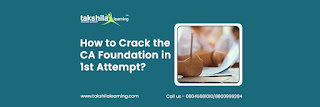Tips Crack the CA Foundation
The CA certification verifies that the individual has received certification from a statutory body and that the individual is knowledgeable in a wide range of accounting and business topics, including business taxation, investment records, financial information auditing, and business practises auditing, among others. CAs are also qualified to advise firms on financial matters.
It's no wonder that the certification is difficult to obtain because it is regarded as respected throughout the country. As a result, we'll go over some brief strategies to help you pass the CA foundation test on your first try.
1. Practise & Practise
There is no such thing as an excessive number of mock tests or practise papers. As a result, write as many mock tests and practise revision papers as you can to become used to an exam setting, a wide range of questions, and extensive study periods.
Attempting to answer as many questions from the revision exam papers as possible also aids in determining your strengths and weaknesses. This will assist you in developing a strategy for taking the exam.
2. Do not deviate from your study materials.
Many students cave to exam demands and attempt to read content from a variety of sources and writers. However, this can be confusing so close to your exam, or it can cause you to lose confidence if the information covered differs. As a result, you must stick to the study resources you've been using since the start of your studies.
Additionally, keep up to current on any curriculum changes and make sure you have the proper study materials for your exam.
3. Make your own timetable
Schedules should always be realistic, but not too loose. As a result, creating a timetable that pushes you to your limits while still allowing you to take it easy is always a good idea. Check out our blog for CMA candidates, where we talk about how to create a timetable using the SMART method. Another tip is to create a schedule well ahead of time for your exam. That way, you can spread your subjects out over multiple days and then study for each one according to how you choose to divide your time.
4. Make a study plan for the exam.
The exam's structure allows you 15 minutes to go over the question paper. So devise a technique that allows you to make the most of those 15 minutes by properly analysing the question paper. During those 15 minutes, make a list of the questions you are most familiar with and try to answer them first. The remaining tasks can be handled later. If you don't know the answer to a question, skip to the next one.
Click for more Tips for Crack the CA Foundation
Tag - How to Crack the CA Foundation? Tips to Crack the CA Foundation; Tips Crack the CA Foundation, ca foundation class

Comments
Post a Comment
Thank you we will contact ASAP.